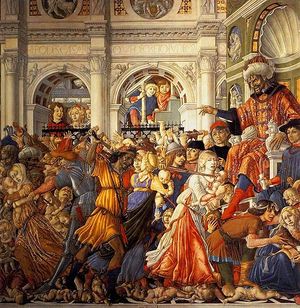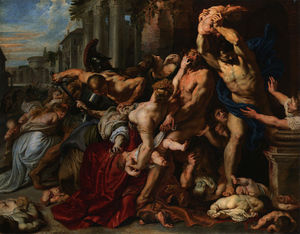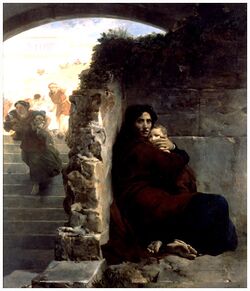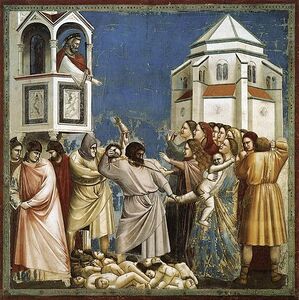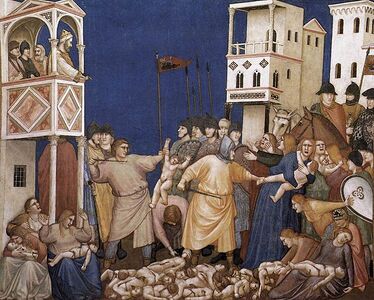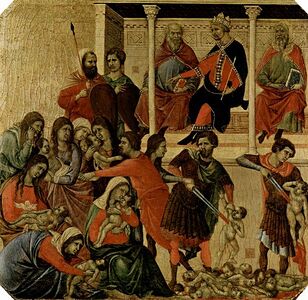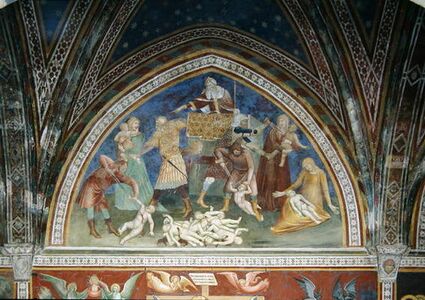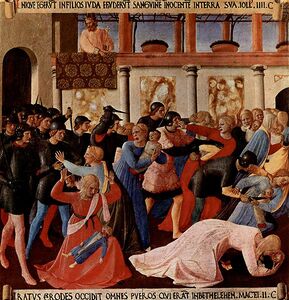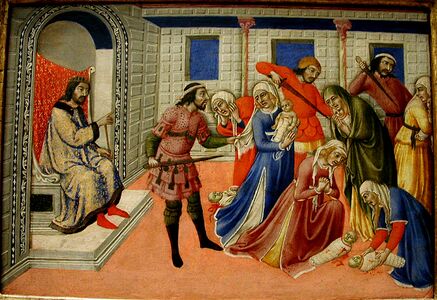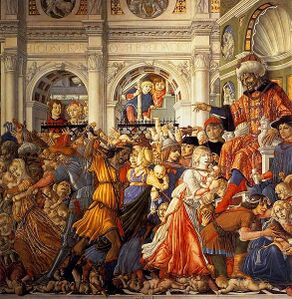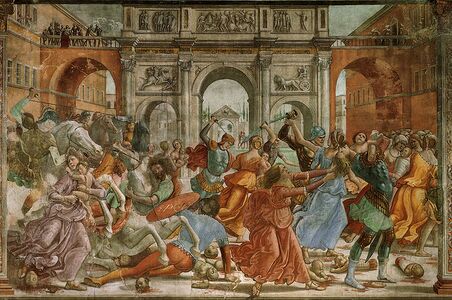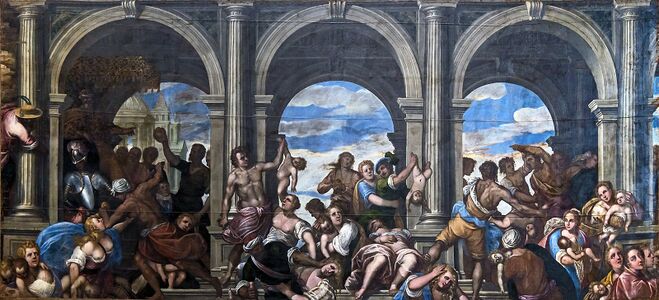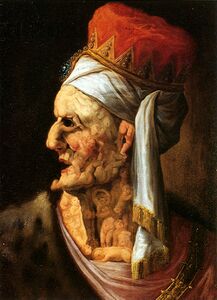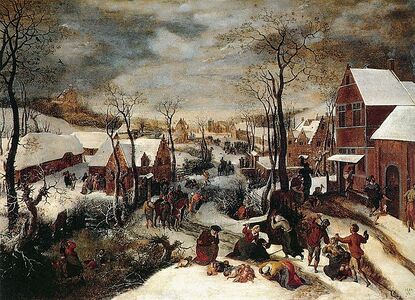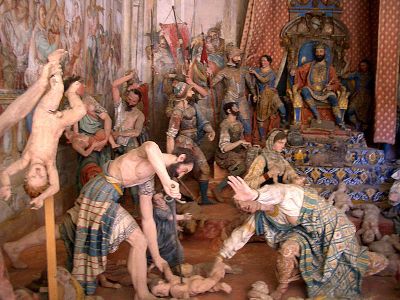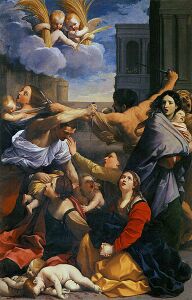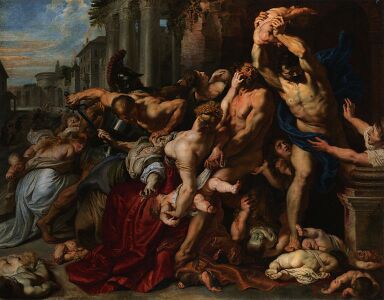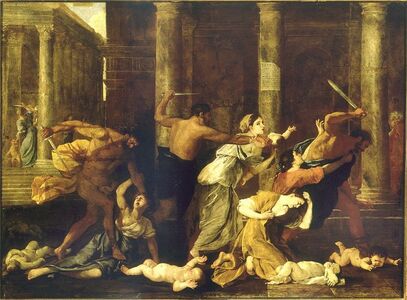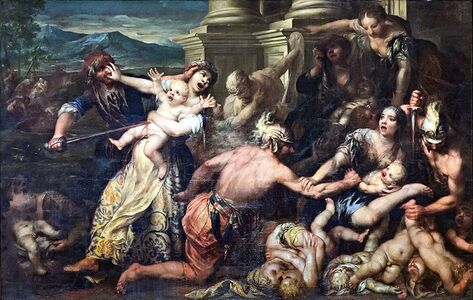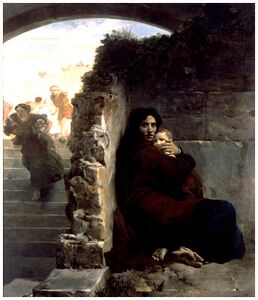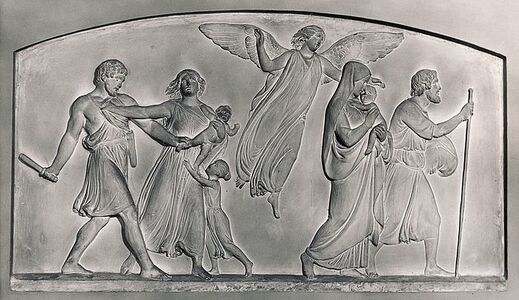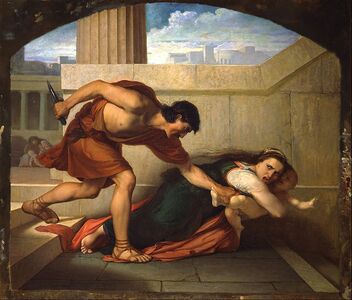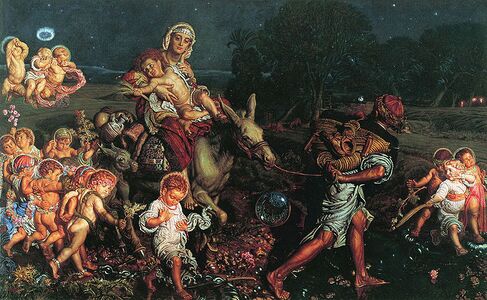Difference between revisions of "Category:Massacre of the Innocents (subject)"
| (41 intermediate revisions by the same user not shown) | |||
| Line 1: | Line 1: | ||
[[File:Innocents Matteo.jpg|thumb|300px|[[Massacre of the Innocents (1488 Matteo di Giovanni), art]]]] | |||
[[File:Innocents Rubens.jpg|thumb|300px|[[Massacre of the Innocents (1612 Rubens), art]]]] | |||
[[File:Innocents Cogniet.jpg|thumb|250px|[[Massacre of the Innocents (1824 Cogniet), art]]]] | |||
*[[:Category:Events|BACK TO THE EVENTS--INDEX]] | |||
*[[Gospel of Matthew|BACk to the GOSPEL OF MATTHEW]] -- [[Protoevangelium of James|PROTOEVANGELIUM OF JAMES]] | |||
*[[Jesus of Nazareth|BACK to JESUS OF NAZARETH]] -- [[Herod the Great|HEROD THE GREAT]] -- [[Mary of Nazareth|MARY OF NAZARETH]] -- [[Joseph of Nazareth|JOSEPH OF NAZARETH]] -- [[Elizabeth|ELIZABETH]] -- [[John the Baptist|JOHN THE BAPTIST]] | |||
The '''Massacre of the Innocents''' refers to an episode in the lives of [[Jesus of Nazareth]], [[Mary of Nazareth]] and [[Herod the Great]], narrated only in the [[Gospel of Matthew]] (Mt 2:16-18). | The '''Massacre of the Innocents''' refers to an episode in the lives of [[Jesus of Nazareth]], [[Mary of Nazareth]] and [[Herod the Great]], narrated only in the [[Gospel of Matthew]] (Mt 2:16-18). | ||
* ''[[Nativity of Jesus]]'' : [[Genealogy of Jesus]] -- [[Annunciation to Mary]] -- [[Annunciation to Joseph]] -- [[Visitation of Mary]] -- [[Birth of Jesus]] -- [[Adoration of the Shepherds]] -- [[Adoration of the Magi]] -- [[Circumcision of Jesus]] -- [[Presentation of Jesus at the Temple]] -- [[Massacre of the Innocents]] -- [[Flight into Egypt]] | |||
< ''Life of Jesus'' : [[Nativity of Jesus]] -- [[Jesus' Hidden Years]] -- [[Ministry of Jesus]] ([[Parables of Jesus]], [[Miracles of Jesus]]) -- [[Passion of Jesus]] -- [[Resurrection of Jesus]] -- [[Relics of Jesus]] > | |||
< ''[[Life of Mary of Nazareth]]'' : [[Expulsion of Joachim from the Temple]] -- [[Annunciation to Anne and Joachim]] -- [[Birth of Mary]] -- [[Girlhood of Mary]] ([[Education of the Virgin]], [[Presentation of Mary at the Temple]]) -- [[Marriage of Mary and Joseph]] -- [[Annunciation to Mary]] -- [[Visitation of Mary]] -- [[Birth of Jesus]] -- [[Adoration of the Shepherds]] -- [[Adoration of the Magi]] -- [[Circumcision of Jesus]] -- [[Presentation of Jesus at the Temple]] -- [[Massacre of the Innocents]] -- [[Flight into Egypt]] -- [[Jesus among the Doctors]] -- [[Death of Joseph of Nazareth]] -- [[Wedding at Cana]] -- [[Jesus' True Relatives]] -- [[Hometown Rejection]] -- [[Crucifixion of Jesus]] -- [[Resurrection of Jesus]] -- [[Ascension of Jesus]] -- [[Gathering of the Twelve at Jerusalem]] -- [[Christian Pentecost]] -- [[Death of Mary|Death and Assumption of Mary]] -- [[Relics of Mary of Nazareth]] > | |||
==Overview== | ==Overview== | ||
== | According to the Gospel of Matthew, when the [[Magi]] failed to report the identity of the "newborn king of the Jews" (see [[Adoration of the Magi]]), [[Herod the Great]] ordered the killing of all of all young male children at [[Bethlehem]]. The incident is interpreted as the fulfillment of a passage from Jeremiah (31:15). Jesus and his family, alerted by an angel, escaped the massacre (see [[Flight into Egypt]]). | ||
The mid-2th century [[Protoevangelium of James]] provides a different account of the miraculous salvation of the infant [[Jesus]] and brings [[John the Baptist]] also in the story. It also claims that John's father [[Zacharias]] was executed by Herod at that time. | |||
At the beginning of the 5th century the non-Christian writer Macrobius shows how by that time the story had penetrated the culture at large; the reference to Herod killing his own son betrays the actual origins of the legend. | |||
The historicity of the literary episode is denied by contemporary scholars. The event was inspired by [[Herod the Great|Herod]]'s notorious brutality against all those whom he perceived as a threat to his throne, including his own children (see [[Josephus]]). In the Matthew narrative, which aims to present Jesus as the new Moses, the episode is patterned on the Exodus story of the killing of the Hebrew firstborn by Pharaoh. | |||
==Massacre of the Innocents, in ancient sources== | |||
====[[Gospel of Matthew]]==== | |||
* ... -> [[Annunciation to Joseph]] -> [[Birth of Jesus]] -> [[Adoration of the Magi]] -> ''Massacre of the Innocents'' -> [[Flight into Egypt]] -> [[Preaching of John the Baptist]] -> [[Baptism of Jesus]] -> ... | |||
Matthew 2:16-18 (NRSV) -- ''[16] When Herod saw that he had been tricked by the wise men, he was infuriated, and he sent and killed all the children in and around Bethlehem who were two years old or under, according to the time that he had learned from the wise men. [17] Then was fulfilled what had been spoken through the prophet Jeremiah: [18] "A voice was heard in Ramah, wailing and loud lamentation, Rachel weeping for her children; she refused to be consoled, because they are no more." '' | Matthew 2:16-18 (NRSV) -- ''[16] When Herod saw that he had been tricked by the wise men, he was infuriated, and he sent and killed all the children in and around Bethlehem who were two years old or under, according to the time that he had learned from the wise men. [17] Then was fulfilled what had been spoken through the prophet Jeremiah: [18] "A voice was heard in Ramah, wailing and loud lamentation, Rachel weeping for her children; she refused to be consoled, because they are no more." '' | ||
====Cf. Protoevangelium of James (2nd cent. CE)==== | ====Cf. [[Protoevangelium of James]] (2nd cent. CE)==== | ||
''And when [[Herod]] knew that he had been mocked by the Magi, in a rage he sent murderers, saying to them: Slay the children from two years old and under. And [[Mary]], having heard that the children were being killed, was afraid, and took the infant and swaddled Him, and put Him into an ox-stall. And [[Elizabeth]], having heard that they were searching for John, took him and went up into the hill-country, and kept looking where to conceal him. And there was no place of concealment. And [[Elizabeth]], groaning with a loud voice, says: O mountain of God, receive mother and child. And immediately the mountain was cleft, and received her. And a light shone about them, for an angel of the Lord was with them, watching over them.'' | |||
'' | |||
== | ====Cf. [[Macrobius, Saturnalia]] (early 5th cent. CE)==== | ||
''When he (i.e. Emperor [[Augustus]]) heard that among the boys in Syria under two years old whom [[Herod]], king of the Jews, had ordered to kill, his own son was also killed, he said: it is better to be Herod's pig, than his son.'' | |||
== | ==Massacre of the Innocents, in the arts== | ||
The Massacre of the Innocents is a recurring subject in Christian iconography. | |||
* See [https://www.christianiconography.info/holyInnocents.html Christian Iconography] | |||
The Massacre of the Innocents is a recurring subject in Christian iconography. At the beginning the focus was on [[Herod the Great]] who ordered the slaughter. By the end of the 15th century, the emphasis shifted more and more from the perpetrator to the victims (the mothers and the children), and Herod gradually disappeared from the scene. Neither Jesus nor members of his family are present at the scene. In the [[Triumph of the Innocents (1884 Hunt), art]], the souls of the dead children accompany Jesus and his family in their [[Flight into Egypt]]. | |||
<gallery mode=packed align=left heights=200> | |||
File:Innocents 1306 Giotto.jpg|[[Massacre of the Innocents (1306 Giotto), art]] | |||
File:Innocents 1310 Giotto.jpg|[[Massacre of the Innocents (1310 Giotto), art]] | |||
File:Innocents Duccio.jpg|[[Massacre of the Innocents (1311 Duccio), art]] | |||
File:Innocents Memmi.jpg|[[Massacre of the Innocents (1340 Memmi), art]] | |||
File:Innocents Angelico.jpg|[[Massacre of the Innocents (1452 Angelico), art]] | |||
File:Innocents Sano.jpg|[[Massacre of the Innocents (1470 Sano di Pietro), art]] | |||
File:Innocents Matteo.jpg|[[Massacre of the Innocents (1488 Matteo di Giovanni), art]] | |||
File:Massacre Innocents Ghirlandaio.jpg|[[Massacre of the Innocents (1490 Ghirlandaio), art]] | |||
File:Innocents Galvano.jpg|[[Massacre of the Innocents (c1550 Galvano), art]] | |||
File:Herod Arcimboldo.jpg|[[Herod (1566 Arcimboldo), art]] | |||
File:Innocents Valkenborch.jpg|[[Massacre of the Innocents (1586 Valkenborch), art]] | |||
File:Innocents Paracca.jpg|[[Herod Orders the Slaughter of the Innocents (1587 Paracca), art]] | |||
File:Innocents Reni.jpg|[[Massacre of the Innocents (1611 Reni), art]] | |||
File:Innocents Rubens.jpg|[[Massacre of the Innocents (1612 Rubens), art]] | |||
File:Innocents Poussin.jpg|[[Massacre of the Innocents (1628 Poussin), art]] | |||
File:Innocents Bambini.jpg|[[Massacre of the Innocents (c1720 Bambini), art]] | |||
File:Innocents Cogniet.jpg|[[Massacre of the Innocents (1824 Cogniet), art]] | |||
File:Innocents Thorvaldsen.jpg|[[Massacre of the Innocents and Flight into Egypt (1842 Thorvaldsen), art]] | |||
File:Innocents Visconti.jpg|[[Massacre of the Innocents (1861 Visconti), art]] | |||
File:Innocents Hunt.jpg|[[Triumph of the Innocents (1884 Hunt), art]] | |||
</gallery> | |||
====Massacre of the Innocents, in the movies==== | |||
* [[Il vangelo secondo Matteo (The Gospel According to St. Matthew / 1964 Pasolini), film]] -- The movie follows the Matthean narrative. | |||
==Related categories== | |||
*[[Jesus of Nazareth]] / [[Nativity of Jesus]] / [[Adoration of the Magi]] / [[Flight into Egypt]] | *[[Jesus of Nazareth]] / [[Nativity of Jesus]] / [[Adoration of the Magi]] / [[Flight into Egypt]] | ||
*[[Mary of Nazareth]] / [[Joseph of Nazareth]] | *[[Mary of Nazareth]] / [[Joseph of Nazareth]] | ||
| Line 28: | Line 91: | ||
==External links== | ==External links== | ||
*[http://en.wikipedia.org/wiki/Massacre_of_the_Innocents Wikipedia] | *[http://en.wikipedia.org/wiki/Massacre_of_the_Innocents Wikipedia] | ||
[[Category: | |||
[[Category:Events]] | [[Category:Index (database)]] | ||
[[Category:Events (database)]] | |||
Latest revision as of 09:28, 14 February 2021
- BACK TO THE EVENTS--INDEX
- BACk to the GOSPEL OF MATTHEW -- PROTOEVANGELIUM OF JAMES
- BACK to JESUS OF NAZARETH -- HEROD THE GREAT -- MARY OF NAZARETH -- JOSEPH OF NAZARETH -- ELIZABETH -- JOHN THE BAPTIST
The Massacre of the Innocents refers to an episode in the lives of Jesus of Nazareth, Mary of Nazareth and Herod the Great, narrated only in the Gospel of Matthew (Mt 2:16-18).
- Nativity of Jesus : Genealogy of Jesus -- Annunciation to Mary -- Annunciation to Joseph -- Visitation of Mary -- Birth of Jesus -- Adoration of the Shepherds -- Adoration of the Magi -- Circumcision of Jesus -- Presentation of Jesus at the Temple -- Massacre of the Innocents -- Flight into Egypt
< Life of Jesus : Nativity of Jesus -- Jesus' Hidden Years -- Ministry of Jesus (Parables of Jesus, Miracles of Jesus) -- Passion of Jesus -- Resurrection of Jesus -- Relics of Jesus >
< Life of Mary of Nazareth : Expulsion of Joachim from the Temple -- Annunciation to Anne and Joachim -- Birth of Mary -- Girlhood of Mary (Education of the Virgin, Presentation of Mary at the Temple) -- Marriage of Mary and Joseph -- Annunciation to Mary -- Visitation of Mary -- Birth of Jesus -- Adoration of the Shepherds -- Adoration of the Magi -- Circumcision of Jesus -- Presentation of Jesus at the Temple -- Massacre of the Innocents -- Flight into Egypt -- Jesus among the Doctors -- Death of Joseph of Nazareth -- Wedding at Cana -- Jesus' True Relatives -- Hometown Rejection -- Crucifixion of Jesus -- Resurrection of Jesus -- Ascension of Jesus -- Gathering of the Twelve at Jerusalem -- Christian Pentecost -- Death and Assumption of Mary -- Relics of Mary of Nazareth >
Overview
According to the Gospel of Matthew, when the Magi failed to report the identity of the "newborn king of the Jews" (see Adoration of the Magi), Herod the Great ordered the killing of all of all young male children at Bethlehem. The incident is interpreted as the fulfillment of a passage from Jeremiah (31:15). Jesus and his family, alerted by an angel, escaped the massacre (see Flight into Egypt).
The mid-2th century Protoevangelium of James provides a different account of the miraculous salvation of the infant Jesus and brings John the Baptist also in the story. It also claims that John's father Zacharias was executed by Herod at that time.
At the beginning of the 5th century the non-Christian writer Macrobius shows how by that time the story had penetrated the culture at large; the reference to Herod killing his own son betrays the actual origins of the legend.
The historicity of the literary episode is denied by contemporary scholars. The event was inspired by Herod's notorious brutality against all those whom he perceived as a threat to his throne, including his own children (see Josephus). In the Matthew narrative, which aims to present Jesus as the new Moses, the episode is patterned on the Exodus story of the killing of the Hebrew firstborn by Pharaoh.
Massacre of the Innocents, in ancient sources
Gospel of Matthew
- ... -> Annunciation to Joseph -> Birth of Jesus -> Adoration of the Magi -> Massacre of the Innocents -> Flight into Egypt -> Preaching of John the Baptist -> Baptism of Jesus -> ...
Matthew 2:16-18 (NRSV) -- [16] When Herod saw that he had been tricked by the wise men, he was infuriated, and he sent and killed all the children in and around Bethlehem who were two years old or under, according to the time that he had learned from the wise men. [17] Then was fulfilled what had been spoken through the prophet Jeremiah: [18] "A voice was heard in Ramah, wailing and loud lamentation, Rachel weeping for her children; she refused to be consoled, because they are no more."
Cf. Protoevangelium of James (2nd cent. CE)
And when Herod knew that he had been mocked by the Magi, in a rage he sent murderers, saying to them: Slay the children from two years old and under. And Mary, having heard that the children were being killed, was afraid, and took the infant and swaddled Him, and put Him into an ox-stall. And Elizabeth, having heard that they were searching for John, took him and went up into the hill-country, and kept looking where to conceal him. And there was no place of concealment. And Elizabeth, groaning with a loud voice, says: O mountain of God, receive mother and child. And immediately the mountain was cleft, and received her. And a light shone about them, for an angel of the Lord was with them, watching over them.
Cf. Macrobius, Saturnalia (early 5th cent. CE)
When he (i.e. Emperor Augustus) heard that among the boys in Syria under two years old whom Herod, king of the Jews, had ordered to kill, his own son was also killed, he said: it is better to be Herod's pig, than his son.
Massacre of the Innocents, in the arts
The Massacre of the Innocents is a recurring subject in Christian iconography. At the beginning the focus was on Herod the Great who ordered the slaughter. By the end of the 15th century, the emphasis shifted more and more from the perpetrator to the victims (the mothers and the children), and Herod gradually disappeared from the scene. Neither Jesus nor members of his family are present at the scene. In the Triumph of the Innocents (1884 Hunt), art, the souls of the dead children accompany Jesus and his family in their Flight into Egypt.
Massacre of the Innocents, in the movies
- Il vangelo secondo Matteo (The Gospel According to St. Matthew / 1964 Pasolini), film -- The movie follows the Matthean narrative.
Related categories
- Jesus of Nazareth / Nativity of Jesus / Adoration of the Magi / Flight into Egypt
- Mary of Nazareth / Joseph of Nazareth
- Herod the Great / Magi
- Bethlehem
External links
Pages in category "Massacre of the Innocents (subject)"
The following 23 pages are in this category, out of 23 total.
1
- Massacre of the Innocents (1306 Giotto), art
- Massacre of the Innocents (1310 Giotto), art
- Massacre of the Innocents (1311 Duccio), art
- Massacre of the Innocents (1340 Memmi), art
- Massacre of the Innocents (1452 Angelico), art
- Massacre of the Innocents (1470 Sano di Pietro), art
- Massacre of the Innocents (1488 Matteo di Giovanni), art
- Massacre of the Innocents (1490 Ghirlandaio), art
- Massacre of the Innocents (c1550 Galvano), art
- Herod (1566 Arcimboldo), art
- Massacre of the Innocents (1586 Valkenborch), art
- Herod Orders the Slaughter of the Innocents (1587 Paracca), art
- Massacre of the Innocents (1611 Reni), art
- Massacre of the Innocents (1612 Rubens), art
- Massacre of the Innocents (1628 Poussin), art
- Herodes infanticida (1632 Heinsius), play
- Massacre of the Innocents (c1720 Bambini), art
- Massacre of the Innocents (1824 Cogniet), art
- Massacre of the Innocents and Flight into Egypt (1842 Thorvaldsen), art
- Massacre of the Innocents (1861 Visconti), art
- Triumph of the Innocents (1884 Hunt), art
- La strage degli innocenti (1900 Perosi), oratorio
